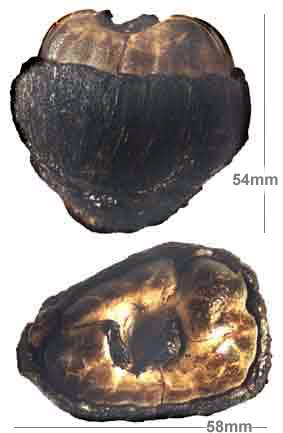 |
| Fruit of the palm Nypa burtini Sheppey Fossils |
Formation: London Clay
Age: Eocene (54-48 Ma)
Scandinavia isn't the only place with a famously cool modern climate that was home to heat-loving organisms during the Eocene. Conjure up an image of Victorian London and, especially at this time of year, you probably find yourself thinking of dark, fog-shrouded streets illuminated by the occasional shop window, tavern, or gas lamp. However, at the same time that authors such as Dickens and Conan Doyle were immortalizing the clammy weather of the great metropolis, paleontologists were beginning to realize that the ground beneath their feet showed that the England of the past was a very different place indeed. Like the Limfjord moler, the London Clay preserves an Eocene shoreline, and like its Danish counterpart it has yielded several bird specimens, along with fish, invertebrates, reptiles, and even the occasional mammal. However, it is the plants that have been found in the clay that provide the most unmistakable evidence that southeast England was once much sunnier. Whereas most of the plant-bearing lagerstätten that I'll be highlighting this month produce primarily leaf and flower fossils, the London Clay tends to preserve harder parts of plants, such as wood, seeds, and nuts. These fossils reveal a flora in which palms were common, as were relatives of cinnamon, monkey puzzle trees, magnolias, cypress, and other trees associated with warm, wet climates. This image of a tropical English coast is reinforced by the remains of terrestrial animals such as crocodiles and primates.
Visit: Exposures of the London Clay outcrop throughout southeast England, though to the best of my knowledge there is no museum or interpretive center devoted exclusively to it.
Fossils: Most museums in England have at least a few London Clay fossils. The largest exhibit I recall seeing is at the Sedgwick Museum in Cambridge.
Is there a relevant book full of gorgeous fossil photos that I can gift to a paleontologically-minded friend?: No, but there are several monographs on fossils from the clay, some dating back to the 19th Century.
This post is part of my 2015 Paleontology Advent Calendar, a series of vignettes on lagerstätten - sites of exceptional fossil preservation - that document changes in climate and environments through the Cenozoic. You can see the other posts here.
No comments:
Post a Comment